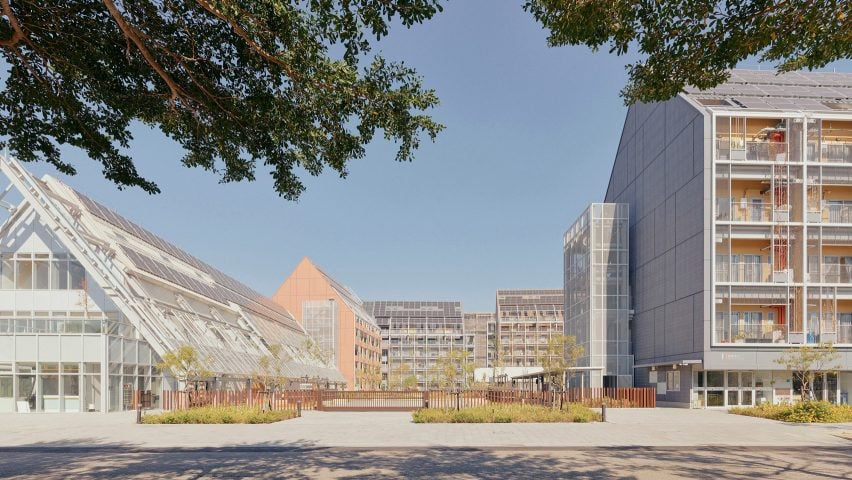Taiwanese studio Bio-Architecture Formosana followed the principles of a circular economy when designing the Taisugar Circular Village, a housing complex in Tainan, Taiwan.
The Taisugar Circular Village (TCV) provides 351 rental homes surrounding an urban farm, eco-pond and waste management area, allowing all of its residents' basic needs to be provided on-site.
According to Bio-Architecture Formosana, it is the first residential project in Taiwan designed around the idea of a circular economy.
"TCV establishes a sustainable framework that cultivates a sense of community," said the studio.
"It transforms residents into integral parts of a shared local ecosystem, fostering a reconnection between people and nature and consumption with production," it continued.
The apartments are organised across three L-shaped buildings, each comprising two separate units connected by external bridges.
Alongside the site entrance, a smaller additional building provides shared facilities for residents, including a laundrette, gym, library, tool store and cafe.
The centre of the site features smaller gabled volumes clad in corrugated polycarbonate panels, which contain a communal kitchen for residents to cook using food from the surrounding urban farm.
TCV was constructed from prefabricated modules to minimise waste, combined with a mixture of hollowed core concrete slabs and steel. These are also designed to be reusable in the future, beyond the useful life of the complex.
Every material element used in its construction was assigned a unique ID or "material passport" to allow the reuse of the materials in future to be tracked.
While all of the blocks are made based on the same modular units, they have been given different external colours of pale pink, brown and grey.
"The residential buildings are identical in plan but vary in height to enhance the village-like aesthetic of the project," said Bio-Architecture Formosana.
"This effect is further emphasised by sloped roofs and slight rotation of each building, which also contributes to more dynamic facade fronts," it added.
Overlooking the courtyard and surrounding landscape, the apartment blocks are finished with gridded metal balconies, assembled with nuts and bolts to enable easy disassembly in future.
Pipework has also been fitted externally as part of these metal frames to facilitate easy repair and maintenance.
"[The buildings] are designed in six layers: foundation, structure, faccade, system, partition, and appliances," explained the studio. "This allows for isolated repairs without compromising other components," it continued.
"We aimed to make the building modular and simple without sacrificing a dynamic look and interesting layout with shared spaces for residents."
Solar panels top the gabled roofs of each block and the lower facilities block is topped by a steel-framed roof with cut-outs, creating terraces on its upper levels.
Bio-architecture Formosana was founded in Taipei in 1999 by Ching-Hwa Chang and Ying-Chao Kuo.
Other projects recently completed in Taiwan include a series of abandoned mining buildings transformed into a "sanctuary for human connection" by Divooe Zein Architects and a gridded Taipei apartment block by Neri&Hu.
The photography is courtesy of Bio-Architecture Formosana.

